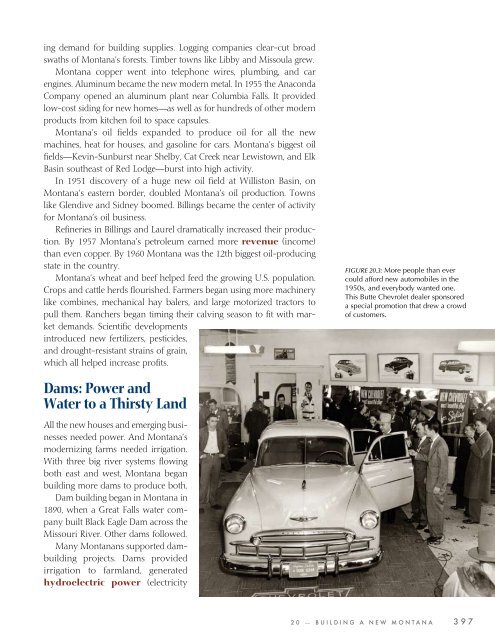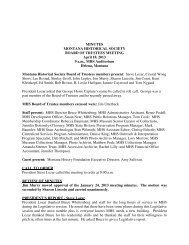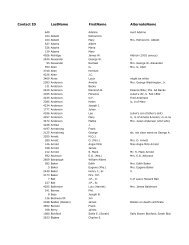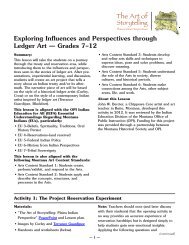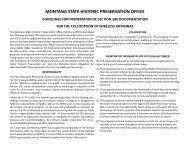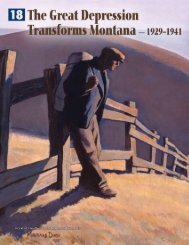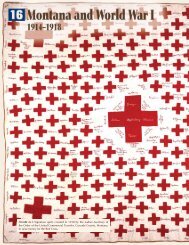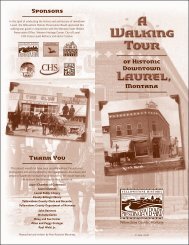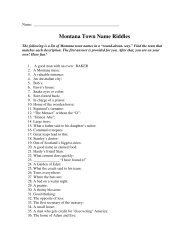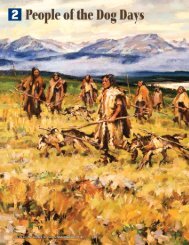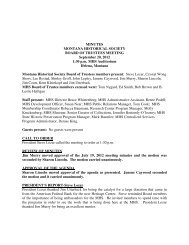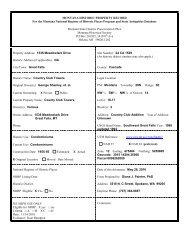Chapter 20 - Montana Historical Society
Chapter 20 - Montana Historical Society
Chapter 20 - Montana Historical Society
You also want an ePaper? Increase the reach of your titles
YUMPU automatically turns print PDFs into web optimized ePapers that Google loves.
ing demand for building supplies. Logging companies clear-cut broad<br />
swaths of <strong>Montana</strong>’s forests. Timber towns like Libby and Missoula grew.<br />
<strong>Montana</strong> copper went into telephone wires, plumbing, and car<br />
engines. Aluminum became the new modern metal. In 1955 the Anaconda<br />
Company opened an aluminum plant near Columbia Falls. It provided<br />
low-cost siding for new homes—as well as for hundreds of other modern<br />
products from kitchen foil to space capsules.<br />
<strong>Montana</strong>’s oil fi elds expanded to produce oil for all the new<br />
machines, heat for houses, and gasoline for cars. <strong>Montana</strong>’s biggest oil<br />
fi elds—Kevin-Sunburst near Shelby, Cat Creek near Lewistown, and Elk<br />
Basin southeast of Red Lodge—burst into high activity.<br />
In 1951 discovery of a huge new oil fi eld at Williston Basin, on<br />
<strong>Montana</strong>’s eastern border, doubled <strong>Montana</strong>’s oil production. Towns<br />
like Glendive and Sidney boomed. Billings became the center of activity<br />
for <strong>Montana</strong>’s oil business.<br />
Refi neries in Billings and Laurel dramatically increased their production.<br />
By 1957 <strong>Montana</strong>’s petroleum earned more revenue (income)<br />
than even copper. By 1960 <strong>Montana</strong> was the 12th biggest oil-producing<br />
state in the country.<br />
<strong>Montana</strong>’s wheat and beef helped feed the growing U.S. population.<br />
Crops and cattle herds fl ourished. Farmers began using more machinery<br />
like combines, mechanical hay balers, and large motorized tractors to<br />
pull them. Ranchers began timing their calving season to fi t with market<br />
demands. Scientifi c developments<br />
introduced new fertilizers, pesticides,<br />
and drought-resistant strains of grain,<br />
which all helped increase profi ts.<br />
Dams: Power and<br />
Water to a Thirsty Land<br />
All the new houses and emerging businesses<br />
needed power. And <strong>Montana</strong>’s<br />
modernizing farms needed irrigation.<br />
With three big river systems fl owing<br />
both east and west, <strong>Montana</strong> began<br />
building more dams to produce both.<br />
Dam building began in <strong>Montana</strong> in<br />
1890, when a Great Falls water company<br />
built Black Eagle Dam across the<br />
Missouri River. Other dams followed.<br />
Many <strong>Montana</strong>ns supported dambuilding<br />
projects. Dams provided<br />
irrigation to farmland, generated<br />
hydroelectric power (electricity<br />
FIGURE <strong>20</strong>.3: More people than ever<br />
could afford new automobiles in the<br />
1950s, and everybody wanted one.<br />
This Butte Chevrolet dealer sponsored<br />
a special promotion that drew a crowd<br />
of customers.<br />
2 0 — B U I L D I N G A N E W M O N T A N A 3 9 7


